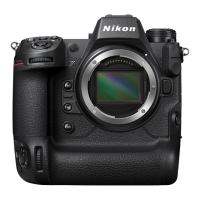
 Loading...
Loading...
Do you have a question about the Nikon Z 9 and is the answer not in the manual?
| Camera Type | Mirrorless |
|---|---|
| Sensor Resolution | 45.7 MP |
| Sensor Size | 35.9 x 23.9 mm |
| Image Processor | EXPEED 7 |
| ISO Range | 64-25600 (expandable to 32-102400) |
| Autofocus Points | 493 |
| LCD Screen | 3.2-inch, 2.1M-dot, tilting touchscreen |
| Shutter Type | Electronic |
| Battery | EN-EL18d |
| Weather Sealing | Yes |
| Continuous Shooting Speed | Up to 20 fps (RAW), 30 fps (JPEG), 120 fps (11MP JPEG) |
| Video Resolution | 8K at 30p, 4K at 120p |
| Viewfinder | 3.69 million-dot OLED EVF |
| Shutter Speed | 1/32000 to 30 sec |
| Storage Media | Dual CFexpress Type B slots |
| Battery Life | Approx. 740 shots |
| Weight | 1340 g |
| Dimensions | 149 x 149.5 x 90.5 mm |
| Connectivity | Wi-Fi, Bluetooth, Ethernet |